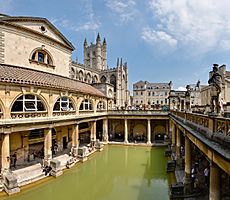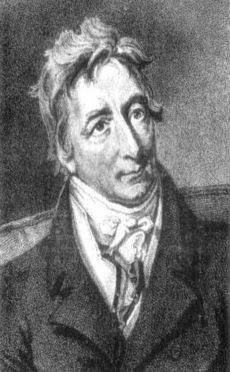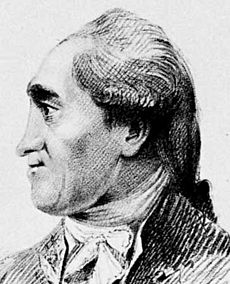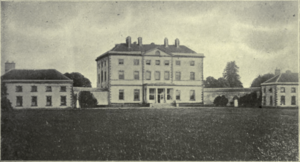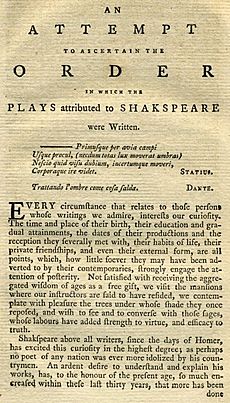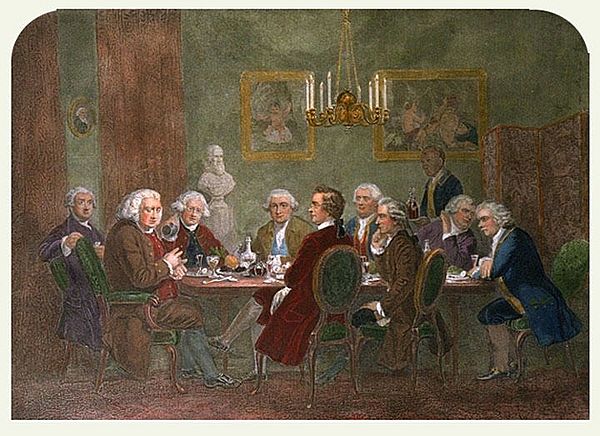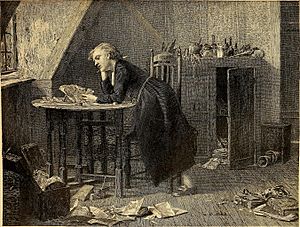Edmond Malone facts for kids
Quick facts for kids
Edmond Malone
|
|
|---|---|

Sir Joshua Reynolds's portrait in oil of Edmond Malone.
|
|
| Born | 4 October 1741 Dublin, Ireland |
| Died | 25 May 1812 (aged 70) London, United Kingdom |
| Occupation | Lawyer, historian |
| Signature | |
Edmond Malone (born October 4, 1741 – died May 25, 1812) was an Irish expert on William Shakespeare. He became famous for editing and studying Shakespeare's plays.
After his father passed away in 1774, Edmond Malone had enough money to stop working as a lawyer. He moved to London and spent his time with writers and artists. He often visited Samuel Johnson, a famous writer, and helped James Boswell with his book, The Life of Samuel Johnson. Malone was also good friends with Sir Joshua Reynolds, a well-known painter, who even painted his portrait.
Malone was one of the first to figure out the order in which Shakespeare's plays were written. This helped people understand Shakespeare's life better through his works. He also added extra information to other editions of Shakespeare's plays. Malone played a key role in proving that some old documents, thought to be Shakespeare's, were actually fakes.
Contents
Edmond Malone: A Shakespeare Detective
Early Life and Education
Edmond Malone was born in Dublin, Ireland, on October 4, 1741. His father, Edmond Malone Sr., was a successful lawyer and a member of the Irish Parliament. His mother was Catherine Collier. Edmond had two sisters and an older brother named Richard.
His father had studied at Oxford University and worked as a lawyer in London before returning to Ireland. The family lived on their country estate called Shinglas in County Westmeath.
When Edmond was six, he went to a school in Dublin. Later, in 1757, he started studying at Trinity College Dublin when he was almost 16. He was a very good student, always at the top of his class. He even won awards for his studies.
As a college student, he wrote poetry and studied literary history. He translated an ancient Greek play, Oedipus Rex, and wrote an essay about old Greek plays. He thought that the "Chorus" (a group of performers in ancient Greek plays) should be brought back into modern plays.
In 1759, his studies were paused when he went to England with his parents. His mother was unwell and went to the Roman Baths in Bath, hoping the waters would help her. Edmond returned to Ireland and continued his studies, earning his Bachelor of Arts degree in 1762.
It was natural for him to study law, as his father, uncle, and grandfather were all lawyers. He started his law studies in London in 1763 at the Inner Temple.
From Law to Literature
While studying law, Malone wrote articles criticizing the government and correcting mistakes in books. He met Samuel Johnson, a very important writer, in 1764. This meeting was very important for Malone, and he became a big admirer of Johnson. They often talked about Shakespeare, as Johnson was working on his own Shakespeare edition at the time.
Malone also traveled to France in 1766. During this trip, he started to doubt if being a lawyer was the right path for him. He missed London's exciting literary scene. Even though he became a lawyer in Ireland in 1767, he didn't find much success or enjoyment in it. He felt bored and longed for the literary world of London.
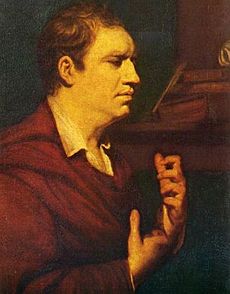
In 1774, Edmond found some old papers by the poet Alexander Pope. He copied them carefully, but they were never published, and the originals are now lost.
He also honored his friend, the writer Oliver Goldsmith, who died in 1774. Malone acted in a play by Goldsmith and wrote a long poem for the event. This play had a strong patriotic feeling, with Irish politicians like Henry Grattan and Henry Flood also taking part.
Malone was interested in Irish politics. His father died in 1774, leaving Edmond with a steady income. This allowed him to leave his law career and follow his passion for literature. He even thought about becoming a Member of Parliament.
However, when his uncle, Anthony Malone, died in 1776, Edmond inherited a good amount of money. This made him financially independent, meaning he could choose to focus on his studies instead of politics. He decided to help with a new edition of Goldsmith's works. He went to London to gather information and stories about Goldsmith.
In 1777, he published a short biography of Goldsmith and notes for his poems and plays. This was based on existing information and stories he collected.
His Big Break: Shakespeare Studies
While in London in 1776, Malone met George Steevens, who was editing Shakespeare's works. Steevens invited Malone to help him. Malone moved near London and sent many notes and corrections to Steevens. In 1778, The Plays of William Shakspeare was published. Malone's most important part was an essay called "An Attempt to Ascertain the Order in Which the Plays Attributed to Shakspeare Were Written." This essay was very well-received and made him famous.
After this success, he moved to London. In 1779, he had his portrait painted by Joshua Reynolds, a famous artist. Malone became good friends with Reynolds and was one of the people who handled Reynolds's affairs after he died.
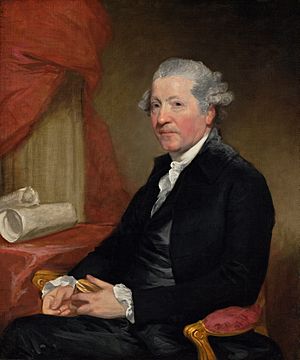
Malone then worked on adding more information to the Johnson–Steevens Shakespeare edition. He included less-known plays, poems, and sonnets by Shakespeare. He worked closely with Steevens, but they sometimes disagreed. Malone wanted to create a completely new and more scientific edition of Shakespeare.
In 1780, A Supplement to the Edition of Shakespeare was published. It received good reviews, even though Steevens, who owned a newspaper, tried to criticize it anonymously.
Social Connections and "The Club"
By the early 1780s, Malone was well-known and spent time with many important writers and theater people. He often ate with famous figures like Samuel Johnson, George Steevens, and Joshua Reynolds.
Malone really wanted to join "The Club", a very exclusive group started by Johnson and Reynolds. It was hard to get in because they only had 35 members, and new spots only opened when someone died. After a famous actor, David Garrick, died in 1779, they kept his spot open for a while.
Finally, on February 5, 1782, Malone was accepted into The Club. He quickly became a very active member and even became its treasurer. He hoped to see Johnson more often, but Johnson's health was getting worse. Malone visited Johnson at his home and wrote down their conversations, which James Boswell later used in his famous book about Johnson.
Debunking Forgeries
In 1769, a young poet named Thomas Chatterton claimed he had found old poems written by a 15th-century monk. Many people believed him, and the poems were published in 1777. This caused a big debate about whether they were real or fake.
Malone, being a lawyer and an expert in old English literature, quickly stepped in. He had no patience for fake writings. In December 1781, he wrote an anonymous article in The Gentleman's Magazine arguing that the poems were not real. He later published a longer essay called Cursory Observations on the Poems Attributed to Thomas Rowley. In this essay, he showed that Chatterton's poems used ideas from much later writers like Shakespeare and Pope, proving they were fakes.
His Legacy and Collections
Malone spent many years working on his own multi-volume edition of Shakespeare's plays, published in 1790. His work included essays on the history of theater, a biography of Shakespeare, and arguments against the authenticity of some plays. His careful research and respect for the original texts were highly praised.
He was also one of the first to expose the Ireland Shakespeare forgeries in 1796. These were fake documents and writings claimed to be by Shakespeare. Malone's work helped prove they were not real. He also published a detailed edition of John Dryden's works in 1800.
After Malone's death, his older brother, Lord Sunderlin, gave most of Malone's large book collection to the Bodleian Library in 1821. This collection included many rare books and notes. The library continued to acquire more of Malone's papers, letters, and research notes over the years, showing how important his collection was. Many of his books have his initials "E. M." on the back.
Malone was working on a new edition of Shakespeare when he died. His materials were given to James Boswell the Younger, who used them to create a large, 21-volume edition of Shakespeare in 1821.
The Malone Society, a group dedicated to studying English plays from the 16th and early 17th centuries, is named after him.
What He Wrote
- 1778 – "An Attempt to Ascertain the Order in Which the Plays Attributed to Shakspeare Were Written" (an essay about the order of Shakespeare's plays).
- 1780 – Supplement to Johnson and Steevens's edition of Shakespeare's Plays (extra volumes for Shakespeare's works).
- 1782 – Cursory Observations on the Poems Attributed to Thomas Rowley (his essay proving the Chatterton poems were fakes).
- 1790 – The Plays and Poems of William Shakespeare (his own major edition of Shakespeare's works).
- 1796 – An inquiry into the authenticity of certain miscellaneous papers and legal instruments... attributed to Shakspeare (his work exposing the Ireland forgeries).
- 1800 – The Critical and Miscellaneous Prose Works of John Dryden (a collection of Dryden's writings).
- 1801 – The Works of Sir Joshua Reynolds, Knight (a collection of Reynolds's works).
- 1809 – Parliamentary Logick (writings by William Gerard Hamilton, with notes by Samuel Johnson).
- 1821 – Life of Shakespeare (published after his death in a new edition of Shakespeare's works).
See also
- Shakespeare's editors
Sources
 This article incorporates text from a publication now in the public domain: Cousin, John William (1910). "Malone, Edmund". A Short Biographical Dictionary of English Literature. London: J. M. Dent & Sons. Wikisource
This article incorporates text from a publication now in the public domain: Cousin, John William (1910). "Malone, Edmund". A Short Biographical Dictionary of English Literature. London: J. M. Dent & Sons. Wikisource- Prior, James (2010). Life of Edmond Malone, Editor of Shakespeare: With Selections from His Manuscript Anecdotes. London: Smith, Elder & Co.. ISBN 978-1-144-93232-7.



